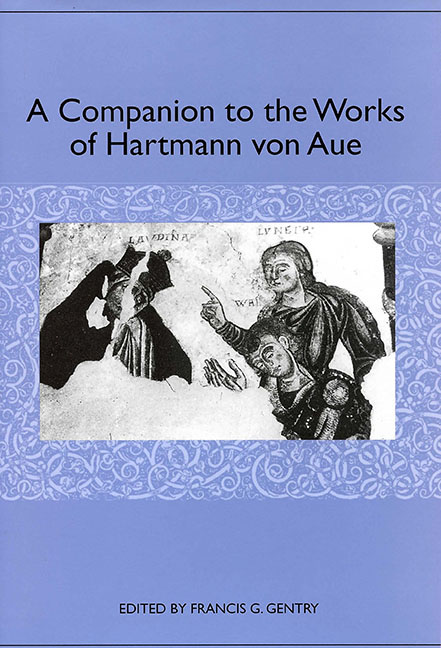Book contents
- Frontmatter
- Contents
- Acknowledgments
- Introduction
- Hartmann's Theological Milieu
- Hartmann von Aue as Lyricist
- Hartmann von Aue and Chrétien de Troyes: Respective Approaches to the Matter of Britain
- Gender and Love in the Epic Romances of Hartmann von Aue
- The Two-Fold Path: Erec and Enite on the Road to Wisdom
- The Body in Pain in the Works of Hartmann von Aue
- Illness and Cure in Hartmann von Aue's Arme Heinrich and Iwein
- Hartmann's Legends and the Bible
- Hartmann's Works in the Visual Arts
- The Medieval Literary Reception of Hartmann's Works
- A Tale of Sacrifice and Love: Literary Way Stations of the Arme Heinrich from the Brothers Grimm to Tankred Dorst
- Editions and Translations of Hartmann's Works
- Works Cited
- Notes on the Contributors
- Index
Hartmann von Aue and Chrétien de Troyes: Respective Approaches to the Matter of Britain
Published online by Cambridge University Press: 27 April 2017
- Frontmatter
- Contents
- Acknowledgments
- Introduction
- Hartmann's Theological Milieu
- Hartmann von Aue as Lyricist
- Hartmann von Aue and Chrétien de Troyes: Respective Approaches to the Matter of Britain
- Gender and Love in the Epic Romances of Hartmann von Aue
- The Two-Fold Path: Erec and Enite on the Road to Wisdom
- The Body in Pain in the Works of Hartmann von Aue
- Illness and Cure in Hartmann von Aue's Arme Heinrich and Iwein
- Hartmann's Legends and the Bible
- Hartmann's Works in the Visual Arts
- The Medieval Literary Reception of Hartmann's Works
- A Tale of Sacrifice and Love: Literary Way Stations of the Arme Heinrich from the Brothers Grimm to Tankred Dorst
- Editions and Translations of Hartmann's Works
- Works Cited
- Notes on the Contributors
- Index
Summary
The two romances of Chrétien de Troyes that were adapted by Hartmann, Erec and Yvain, coexist in a symbiotic relationship. While in Erec the abandoning of chivalric activities and social responsibility precipitates a crisis that launches the major plot, in Yvain it is the opposite, namely there is too much emphasis on chivalric activity. Both works exhibit a similar narrative structure: rapid attainment of good fortune at the beginning, loss of fortune, followed by a long and arduous path back to new and lasting fortune. This schema can be traced back to the adventure epics of classical antiquity, and is the foundation of religious narrative poetry as well. In view of all these things that they have in common, the differences are quite significant. The earlier effort, Erec, has a more serious tone, and at the end comes close to replicating chivalric and courtly reality. Yvain,on the other hand, is more cheerful and does not need a comparable convergence. Romance as fiction is dominant; history and fantasy are combined into a new unity. Nonetheless, it is necessary to stress that a comparison between Chrétien and Hartmann must be prefaced with the caveat that Hartmann's sources are not necessarily identical with the texts of Chrétien that are available today. And, further, we do not know whether Hartmann proceeded verse by verse or whether he occasionally recapitulated larger segments. (In order to avoid confusion in the following discussion “Erec” will be used when referring to Chrétien's work or main character and “Erek” when referring to Hartmann's.)
Chrétien's romances must be viewed against the background both of Wace's Roman de Brut (1155) and Geoffrey of Monmouth's Historia regum Britanniae (ca. 1138). Unlike his predecessors, however, Chrétien moved beyond a portrayal of the historic figure of Arthur. Instead, he placed selected Arthurian knights at the center of his tales. In the prologue to Erec, for example, he declares programmatically that he will tell of “Erec, the son of Lac.” Thus, we should not speak of Arthurian romances, but rather of romances about Arthurian knights. This change in perspective from the historical view of a great king (rex) to a political-historically irrelevant miles/rex (Erec and Yvain) or to a mere knight (miles) Lancelot marks a literary-historical sea change.
- Type
- Chapter
- Information
- A Companion to the Works of Hartmann von Aue , pp. 43 - 70Publisher: Boydell & BrewerPrint publication year: 2004

